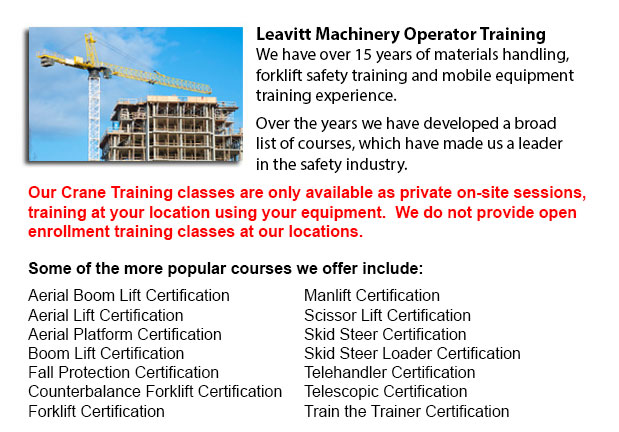
Saskatoon Overhead Crane Safety Training - Overhead crane safety training equips operators with skills and knowledge about crane safety precautions, materials handling, accident avoidance, and machinery and stock protection. Trainees would learn the types of overhead cranes, their capabilities and their uses in different industry settings. For operators who are trained and licensed, the shift in liability moves from the company to the operator. Therefore, the course emphasizes individual operator responsibilities.
Overhead crane safety training instructs operators in the correct ways for performing inspections. Two types of pre-shift inspection are the in-depth inspection and the walk-around inspection. These are important daily routines that must be logged. Properly recorded pre-shift checks help to protect the business from liability in the event of an accident. Pre-shift checks also prevent damage, costly repairs and accidents. Operators learn how to designate a specific individual to carry out checks, how to maintain the log book and how to report problems.
Each check must be carried out and documented on a regular basis. Things that must be inspected for possible concerns, comprise: hooks for cracks, increases in the throat opening, hoist ropes for corrosion, degree of twist, loss of diameter, worn wires, broken wires, bird caging and kinks, chains for gouges and nicks, heat and chemical damage, twists, corrosion and cracks, excessive wear, distortion, stretching, pits, damage caused by extreme heat.
Operators learn proper rigging procedures in this course. Rigging includes understanding the manufacturer's data plate, determining the material weight to be lifted, selecting the gear, and utilizing safe practices to secure the load. The program include in detail the following: safe working loads, and the capacities of ropes, chains, hooks, shackles and slings.
It is essential to understand who could use the cranes at your facility, the job's physical requirements, and operator qualifications required for permits and specialized tasks. Safety is a priority when operating near pedestrian traffic.
The responsibilities involved in the safe crane utilization includes undertaking visual inspections, checking for hydraulic leaks, testing the controls, checking the safety guards, examining the hook and hoist rope, braking mechanisms and limit switches. Correct reporting procedures are important. These subject matters are all covered in depth in the course.
The program likewise consists of the right lifting and moving procedures with hoists and cranes. Operators will likewise learn right hand signals. Training includes how to attach the load, raise the load, set the load, unhook the slings and abort a lift.
Moving the load involves several steps: starting and stopping procedures, guiding and controlling the load, observing working conditions and working with signals. Operators need to know how to proceed in case of a power failure. The course covers methods for removing the slings and lowering the load, parking the crane, storage equipment, and securing an outdoor and indoor crane.
-
Saskatoon Telehandler License
Saskatoon Telehandler License - The telescopic handler or telehandler is a frequently utilized machine in agricultural and industrial applications. This particular equipment is similar in appearance to a forklift and even functions in a similar way,... More -
Saskatoon Zoom Boom Ticket
Saskatoon Zoom Boom Ticket - Zoom Boom Training focuses on correctly training prospective operators on variable reach forklifts. The training objectives consist of gaining the knowledge of the machine's physics and to define the job of the operator.... More -
Saskatoon Forklift Operator Training
Saskatoon Forklift Operator Training - In North America, lift truck operator training is needed in order to prevent workplace injuries and accidents. Particular lift truck training will be provided to offer forklift operators driver training. The saf... More -
Saskatoon Forklift Certification Schools
Saskatoon Forklift Certification Schools - Forklift Certification is mandatory in North America. Hence, forklift training programs are essential both for businesses and for individuals seeking jobs in industries as forklift operators. Forklift traini... More -
Saskatoon Telehandler Training Courses
Saskatoon Telehandler Training Courses - Employers are responsible for making certain that their operating personnel and supervisors are trained to work competently utilizing telehandler machines. The competence level of staff must be assessed. If de... More -
Saskatoon Boom Lift Training
Saskatoon Boom Lift Training - Aerial platforms or likewise known as elevated work platforms are devices that enable workers to perform tasks and duties at elevated heights that will not be otherwise accessible. There are many aerial lifts available... More -
Crane / Overhead Crane / Self-Erect Crane / Truck Mounted Crane / Hydraulic Cranes Training in Saskatoon
Overhead cranes are likewise referred to as bridge cranes. They are a type of crane which comprises a line and hook device that runs along a horizontal beam which runs along two widely separated rails. Several overhead cranes can be found within a lo... More -
Saskatoon Heavy Equipment Training Programs
Saskatoon Heavy Equipment Training Programs - At any given construction site, there are usually different types of machinery which are ready to be used. These light and heavy machinery require both operators to run them and mechanics to fix them. Tra... More

Forklift Certification Saskatoon
TOLL FREE: 1-888-254-6157
Saskatoon, Saskatchewan
forkliftcertificationsaskatoon.com
Email Us
About Us


